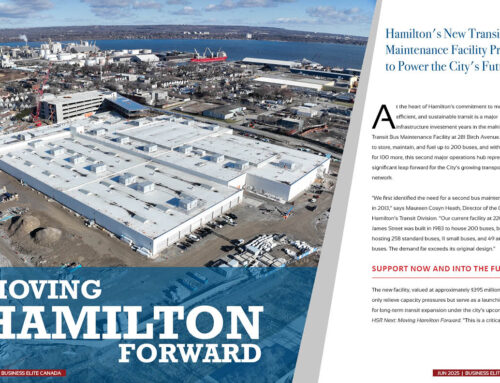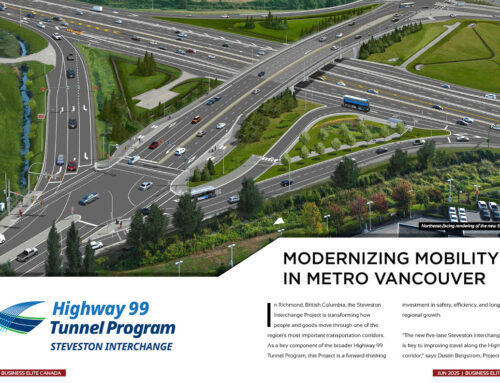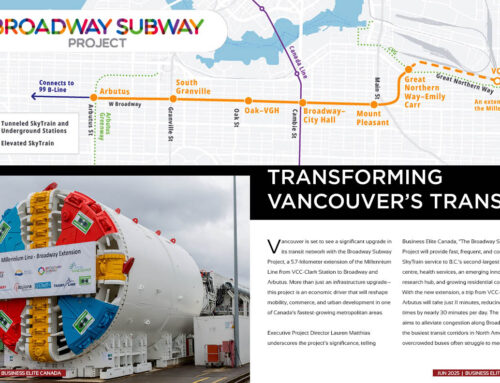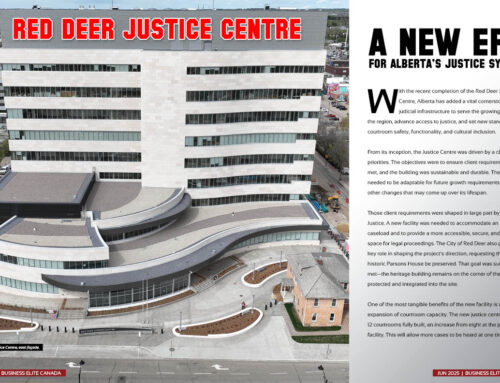Located in the heart of British Columbia’s Fraser Valley, Abbotsford is one of the province’s fastest-growing cities and a vital link between Metro Vancouver and the U.S. border. As it marks its 30th anniversary, the city stands out as a key economic engine fueled by agriculture, advanced manufacturing, and a rising innovation sector. But beyond its industries and strategic location, Abbotsford is defined by a strong sense of community and a spirit of resilience that continues to shape its future. “Abbotsford is the economic and cultural hub of the Fraser Valley,” says Mayor Ross Siemens. “We’re a city of hardworking, innovative, and charitable people. Year after year, Statistics Canada ranks us as the most generous community in Canada, and that spirit is something you see every day here.”
With a population of more than 164,000 and growing, Abbotsford’s appeal is multifaceted. The city boasts the most productive farmland in Canada while also supporting more than 7,700 businesses across sectors like aerospace, agritech, food and beverage processing, transportation, and advanced manufacturing. It’s home to the University of the Fraser Valley, the Abbotsford Regional Hospital and Cancer Centre, and the Abbotsford Canucks AHL franchise—winners of the 2025 Calder Cup Championship.
“We have a unique urban-rural split, and our location, right on Highway 1 and the US/Canada border, just an hour from Vancouver, makes Abbotsford a great place to live, work, play, and invest,” Siemens says.
Growth and Transformation: The Last Five Years
The past half-decade has been transformative for Abbotsford. Alongside steady population growth, Abbotsford City Council has made significant investments in infrastructure, public safety, and transportation. One of the most notable developments was a 30,000-square-foot expansion at Abbotsford International Airport (YXX), which recorded a landmark year in 2023 by welcoming more than 1.2 million passengers. The city also completed a major upgrade to the Abbotsford Police Department headquarters, modernizing the facility to support the demands of a growing population. Another key milestone was the adoption of the McKee Neighbourhood Plan, which sets the framework for the last major residential area within Abbotsford’s current urban boundary.Yet, the most defining event in recent history wasn’t a project—it was a crisis.
In November 2021, historic flooding devastated the region when waters from Washington State’s Nooksack River breached dikes, inundating the Sumas Prairie. More than 3,300 people were evacuated, major transportation routes—including Highway 1 and the US/Canada border—were cut off, and the agricultural sector suffered massive losses.
“It was one of Canada’s largest flooding disasters, and for us, it was deeply personal,” says Siemens. “The main dike breach happened on the site of my wife’s family farm. I understand firsthand what farmers went through—generations of work, washed away.”
Rebuilding Stronger: Infrastructure and Flood Resilience
Recovery began immediately, with the city completing permanent repairs to both main dike breaches, restoring roads and bridges, and stabilizing the Sumas River banks. A phased flood resilience strategy is now underway, including upgrades to the Barrowtown Pump Station and the installation of backup power systems to ensure operations during emergencies.
Despite these efforts, Siemens warns the city remains vulnerable without critical infrastructure investments—particularly when the flood source is outside municipal control.
“The Nooksack River is in Washington State, so while we’re doing everything we can on our side, we need coordination with the US government. We know what needs to be done, but the longer we wait, the greater the risk.”
To date, the Province of British Columbia has committed $76.6 million to flood mitigation efforts in Abbotsford, including Barrowtown upgrades. But securing federal funding and cross-border solutions remains an ongoing priority.
Building for Long-Term Sustainability
Flood recovery is just one element of Abbotsford’s long-term planning. The city’s Official Community Plan emphasizes containing growth within existing urban boundaries while encouraging density and sustainable development.
“We’re developing a Climate Resiliency Strategy to protect natural ecosystems, reduce emissions, and adapt to future climate challenges,” Siemens explains. Initiatives include transitioning the city’s fleet to renewable diesel and electric vehicles, creating a Climate Action Reserve Fund, and pursuing green building policies across municipal operations.
Agriculture, a cornerstone of Abbotsford’s identity, is also central to these plans. Beyond agritech innovation and farmland preservation, the city operates its own irrigation system to help farmers manage climate pressures. By controlling water levels in ditches and drainage canals across Sumas and Matsqui prairies, the system ensures farmers have access to reliable irrigation during dry spells—an unusual municipal service in Canada.
Housing and Affordability
Like many growing cities, Abbotsford faces the challenge of housing supply and affordability. The city has responded by streamlining building permits through a new digital portal, dramatically reducing wait times for developers.
“In 2024 alone, we approved more than 2,000 residential units, with another 2,600 approved in principle,” says Siemens. “Our Affordable Housing Strategy and Housing Needs Report guide our decisions, ensuring we’re creating diverse housing options for all income levels.”
The city has also secured up to $25.6 million through the federal Housing Accelerator Fund, and its Homelessness Action Plan focuses on coordinated services and support for the most vulnerable.
Enhancing Connectivity and Transportation
As the geographically largest city in British Columbia, Abbotsford depends on continued investment in transportation to support its growing population and regional role. Key initiatives include a new transit exchange in Historic Downtown, with another planned for the city’s west side at High Street Shopping Centre; Phase 2 upgrades to Fraser Highway beginning in 2026, which will expand roadways and introduce multi-use pathways; and infrastructure projects like the Marshall Road Connector and Vye Road overpass to improve east-west traffic flow and border access.
The city is also actively advocating for the further widening of Highway 1to Chilliwack—part is now underway—to accommodate the 90,000 vehicles that pass through Abbotsford each day. “We’re also pushing for rapid transit connections from the new SkyTrain extension into the Fraser Valley,” adds Mayor Ross Siemens. “Efficient movement of goods and people is essential to our future.”
Investing in Community Wellbeing
Looking ahead, Abbotsford is focused on building a vibrant, connected community that supports both quality of life and long-term sustainability. As the city continues to grow, plans are underway to enhance cultural programming, expand parks and recreational facilities, and invest in new strategies for arenas, sports fields, and Mill Lake Park. Through initiatives like the Culture Connect Strategy and ongoing collaborations with cultural partners, Abbotsford is setting the stage for a future that is inclusive, dynamic, and economically strong. Mayor Ross Siemens sees the city’s 30th anniversary as a turning point: “This milestone is a celebration of the people who have built Abbotsford into what it is today and a reminder of the opportunity ahead as we continue to grow. If you’re coming to Abbotsford, explore our trails, visit our farms, and experience our thriving local economy. There’s always something happening here.”
For more information, please visit www.abbotsford.ca






